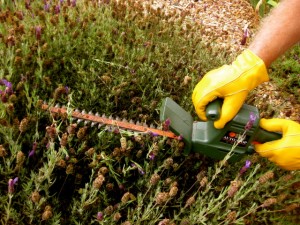
The Spanish Lavender (Lavandula stoechas ‘Otto Quast’) has finished blooming in my coastal garden and its flowers, a vivid purple in the spring (see Spanish Lavender Blooming On the Coast), have turned a dusty brown. They are not the only shrubs with a halo of beige. Most of the Mediterranean plants in my garden have followed suit and are less than brilliant this early July. Mediterranean plants are resting now. This is actually their dormant period. In Mediterranean climates, there is a lack of rain during the summer, and Mediterranean plants have learned to survive with little water until the rains begin again in the fall.

Pruning lavender is relatively easy. You have the option of cutting back your lavender or leaving the faded blooms on the plant. It really doesn’t make much difference in the performance next season. I prefer to prune lavender into a compact grey-green shrub and I am sometimes rewarded with another flush of blooms. This second round of blooms is not as spectacular as the first but it is adds color to a late-summer garden.
You can prune Spanish lavender by grasping the dead blooms with one hand and using clippers to cut them from the plants. Or, like my husband, you can take a small hedge clipper and cut the shrub into a rounded shape. Lavender can be cut back to about two-thirds of their original size. Try to avoid cutting back to old wood as the lavender may never recover. Eventually, as the lilac shrub ages, it will become too woody to be attractive. I have to replace my Spanish lavender every five years. Perhaps with careful pruning, yours will last longer.


I planted two Spanish lavenders at my new house. Previously I had English lavender, which would bloom two or three times a year. I did very little maintenance (except pruning)on the English Lavender yet it flourished (at a different location although climate is similar). ??? Thought I’d try Spanish for something different but it blooms once and blooms are short lived. They look similar to pictures in this article. What can I do to improve their performance or is this just how they are?
Thanks,
John
This year, along the coast, my Spanish lavendar did very poorly. But normally, it blooms, I cut it back, and it blooms another two or three times during the long summer. It is much brighter in color than the English and French lavenders. It is rather short-lived (about 4-5 years) then has to be replaced. You have to be careful not to water it too much. Keep trying, just be sure to cut it back after blooming to keep it full.
Hello Ms. Oliphant,
I would like permission to use your Spanish lavender photo in an article I am writing for the Victoria, Texas newspaper (The Advocate). I will be crediting you, of course. Thank you in advance for your consideration.
Sincerely,
Mary Andrade
Yes, Mary. Thank you for asking. Hope it helps!
One area of my Spanish Lavender (only on one bush), the entire back side of the bush turned gray – like it’s dead but the rest of the plant looks fine. I am going to cut it back this weekend (removal spent blooms) and wasn’t sure if I should cut off the portion of the bush that looks dead? Not sure what caused this but it’s not getting too much water and there isn’t any evidence of insect issues.